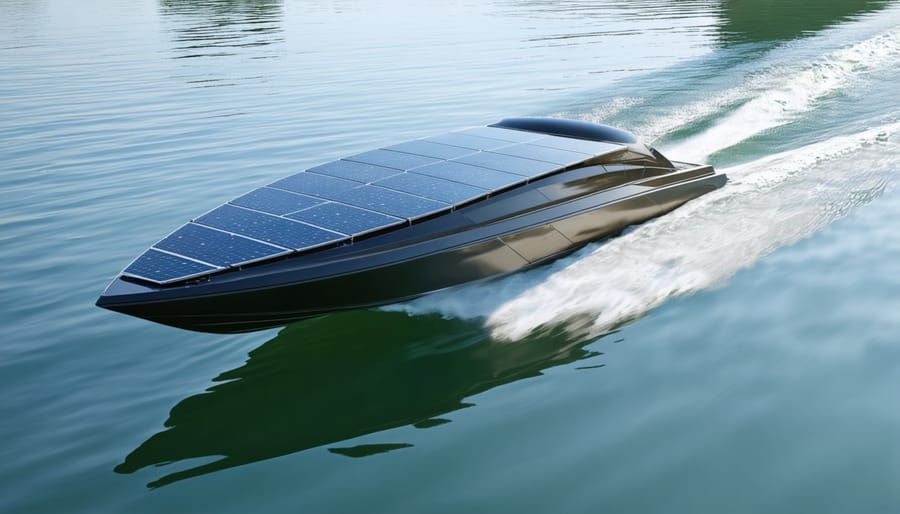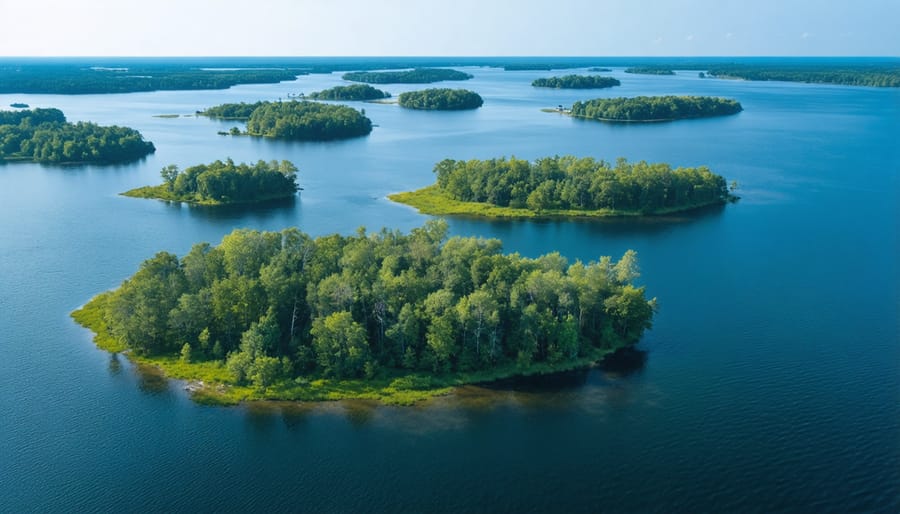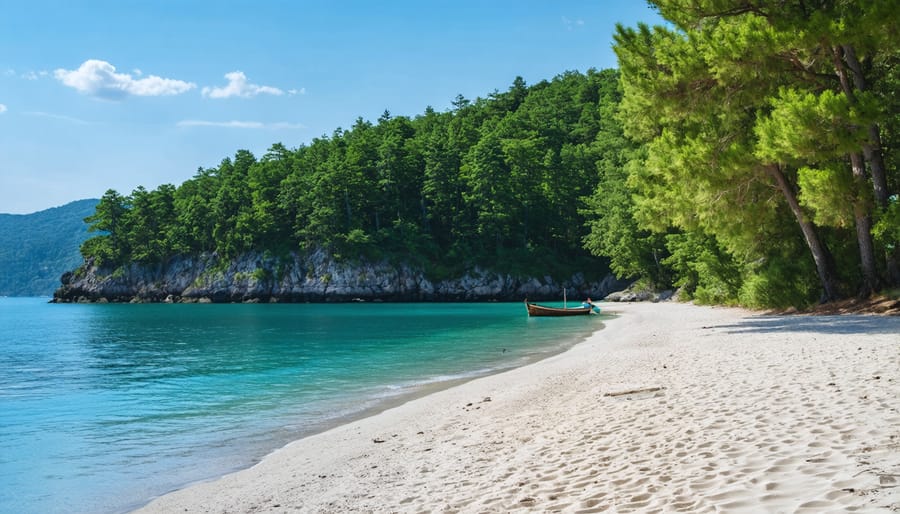Nestled between Toronto and Montreal, the 1000 Islands region beckons with a mesmerizing archipelago of 1,864 islands dotting the crystal-clear waters of the St. Lawrence River. This natural wonder, where granite islands rise from azure waters crowned with windswept pines, offers adventurers an unparalleled opportunity to explore Ontario’s most stunning waterways. Visitors can now experience this pristine paradise through solar-powered boat access, allowing for silent, eco-friendly exploration of hidden coves and secluded channels that larger vessels can’t reach. From the historic Boldt Castle to the hidden fishing spots of Georgina Island, the region serves as a living museum of Canadian heritage while offering modern adventurers everything from kayaking and diving to world-class fishing. Whether you’re seeking a peaceful island retreat or an active outdoor adventure, the 1000 Islands represents Ontario’s perfect blend of natural splendor and accessible wilderness.
Going Green in the 1000 Islands
How Solar-Powered Boats Work
Solar-powered boats are revolutionizing how visitors experience the 1000 Islands, offering one of the most eco-friendly ways to explore parks and waterways. These vessels harness energy from the sun through photovoltaic panels mounted on their roofs, converting sunlight directly into electricity to power silent electric motors.
The boats typically feature a bank of marine batteries that store excess energy, ensuring reliable operation even on cloudy days. With zero emissions and virtually no noise, these craft allow you to glide peacefully through narrow channels and approach wildlife without disturbing them. Most solar boats in the region can cruise for 6-8 hours on a single charge, perfect for a full day of exploration.
The lightweight design and shallow draft of these vessels make them ideal for accessing hidden coves and remote areas that larger boats can’t reach. Many are equipped with comfortable seating, sun protection, and basic navigation equipment, making them suitable for families and nature enthusiasts alike.

Rental Information and Locations
Several marinas along the 1000 Islands waterfront offer convenient boat rentals for your adventure. Gananoque Municipal Marina is a popular starting point, providing well-maintained solar-powered vessels perfect for quiet exploration. Rental rates typically range from $120-200 per day, depending on boat size and season.
In Kingston, you’ll find Collins Bay Marina offering both traditional and eco-friendly rental options. They provide comprehensive orientation sessions and safety equipment with every rental. For a unique experience, check out Ivy Lea Club near Thousand Islands National Park, where you can rent boats equipped with built-in GPS navigation systems.
Pro tip: Book your rental at least two weeks in advance during peak season (July-August). Most locations require a valid driver’s license and boating safety card. Many rentals include basic amenities like coolers and maps, but bring your own snacks and sunscreen. First-time renters should opt for the guided orientation to familiarize themselves with solar boat operation and local waterways.
Must-Visit Ontario Parks by Solar Boat

Thousand Islands National Park
Thousand Islands National Park offers an unparalleled eco-friendly adventure through its network of pristine waterways and verdant islands. Visitors can access the park through several well-maintained docks and launching points, with Mallorytown Landing serving as the primary gateway. Here, you’ll find solar-powered facilities and educational displays about the park’s diverse ecosystem.
The park’s innovative approach to sustainable tourism shines through its electric shuttle boats, which run quietly through the channels, minimizing disruption to local wildlife. These vessels provide access to otherwise hard-to-reach islands while maintaining the serenity of the natural environment.
Nature enthusiasts will appreciate the park’s hiking trails on Mallorytown Landing, McDonald Island, and Camelot Island, each offering unique perspectives of the archipelago’s beauty. The wheelchair-accessible Mallorytown Landing trail features interpretive panels that tell the story of the region’s rich biodiversity.
For paddlers, multiple kayak and canoe launch points dot the shoreline, providing intimate access to hidden coves and peaceful bays. The park’s commitment to conservation is evident in its designated primitive camping sites on several islands, equipped with composting toilets and pack-in-pack-out policies.
Don’t miss the park’s seasonal guided eco-tours, where naturalists share insights about the region’s rare species and delicate ecosystems. These tours often include stops at significant geological formations and historic sites, offering a comprehensive understanding of this unique landscape.
Hidden Coves and Beaches
Among the countless treasures of the 1000 Islands region lie several hidden gems that can only be discovered by water. These secluded coves and pristine beaches offer an exclusive escape for boaters willing to venture off the beaten path.
Half Moon Bay, tucked away on Bostwick Island, stands as one of the area’s best-kept secrets. This natural amphitheater carved into the granite shoreline provides a sheltered spot for anchoring and swimming. Local boaters often gather here during sunset, creating an impromptu community on warm summer evenings.
For those seeking solitude, the secluded beaches of Beaurivage Island offer crystal-clear waters and smooth rocks perfect for sunbathing. Pack a picnic and make sure to bring your underwater camera – the shallow waters around the island teem with colorful fish and fascinating aquatic plants.
Nature enthusiasts won’t want to miss the hidden cove on Georgina Island, where great blue herons often nest in the towering pines. The small sandy beach here is ideal for a quiet afternoon of beachcombing or wildlife watching.
Eco-friendly tip: When visiting these hidden spots, practice “leave no trace” principles. Pack out what you pack in, and avoid disturbing natural habitats or wildlife. Consider using a solar-powered or electric boat to minimize your environmental impact while exploring these pristine locations.
Remember that some of these locations require careful navigation through narrow channels, so it’s best to visit during daylight hours and consult updated nautical charts before your journey.

Planning Your Eco-Adventure
Best Times to Visit
The 1000 Islands region shines brightest from late June through early September when warm temperatures (typically 20-25°C) create perfect conditions for boating, swimming, and outdoor adventures. July and August offer the warmest waters for water activities, though these months also bring the largest crowds.
For a more peaceful experience, consider visiting during the shoulder seasons. Early June and late September still provide comfortable temperatures with fewer tourists, making it easier to explore popular spots. Fall colors peak in late September to mid-October, transforming the islands into a stunning canvas of reds, oranges, and yellows – an incredible sight from both water and hiking trails.
Winter brings its own charm from December through March, with ice fishing, cross-country skiing, and snowshoeing opportunities. However, many water-based attractions and services operate seasonally, typically closing from late October through May.
Pro tip: Book your summer visits well in advance, especially for holiday weekends. Early morning or evening excursions during peak season offer cooler temperatures and better chances of spotting wildlife while avoiding the midday rush.
Safety and Navigation Tips
Navigating the 1000 Islands waterways requires careful attention to safety and proper planning. Always check the weather forecast before heading out, as conditions can change quickly on Lake Ontario and the St. Lawrence River. During peak season (June to September), it’s essential to have updated nautical charts and a GPS device, as the numerous islands and channels can be confusing for first-time visitors.
Boaters should maintain a safe speed, especially in narrow channels and near docks. Watch for marker buoys indicating shallow areas or underwater hazards – red markers should be kept on your starboard (right) side when returning to harbor. The region experiences regular commercial shipping traffic, so stay clear of the main shipping channel and be prepared to give way to larger vessels.
Life jackets are mandatory for everyone on board, and boats must be equipped with required safety gear including a sound-signaling device, navigation lights, and fire extinguisher. For paddlers in kayaks or canoes, wearing bright-colored clothing increases visibility to other boaters.
Keep an eye on changing weather patterns, particularly in late afternoon when winds typically pick up. If you spot approaching dark clouds or lightning, head to the nearest safe harbor. During foggy conditions, reduce speed and use sound signals to alert other vessels of your presence.
Local marinas monitor VHF Channel 16 for emergencies, and many offer mobile pump-out services for proper waste disposal. Remember to respect private island properties and maintain appropriate distances from wildlife. The Ontario Provincial Police marine unit regularly patrols the waters, ensuring boating regulations are followed and providing assistance when needed.
For eco-conscious travelers, consider using electric motors in quiet zones and avoid creating large wakes near shorelines to prevent erosion.
Exploring the 1000 Islands region offers a unique opportunity to connect with nature while preserving its pristine beauty for future generations. By choosing eco-friendly transportation options like solar-powered boats, kayaks, or electric bicycles, visitors can minimize their environmental impact while maximizing their experience of this stunning archipelago.
The region’s commitment to sustainable tourism has created a model for other destinations to follow. From the use of renewable energy at visitor centers to the implementation of waste reduction programs at local businesses, the 1000 Islands community demonstrates that tourism and environmental stewardship can go hand in hand.
As you plan your visit, consider making choices that support these conservation efforts. Stay at eco-certified accommodations, participate in guided nature tours that emphasize environmental education, and support local businesses that prioritize sustainability. Remember to pack reusable water bottles, bring eco-friendly sunscreen, and follow the “leave no trace” principles during your adventures.
The 1000 Islands region proves that responsible tourism enhances rather than diminishes the travel experience. By exploring these waters and islands sustainably, you’re not just creating lasting memories – you’re helping to ensure that this natural wonder remains vibrant and accessible for generations to come. Make your next visit to the 1000 Islands a testament to the power of conscious travel.














+ There are no comments
Add yours